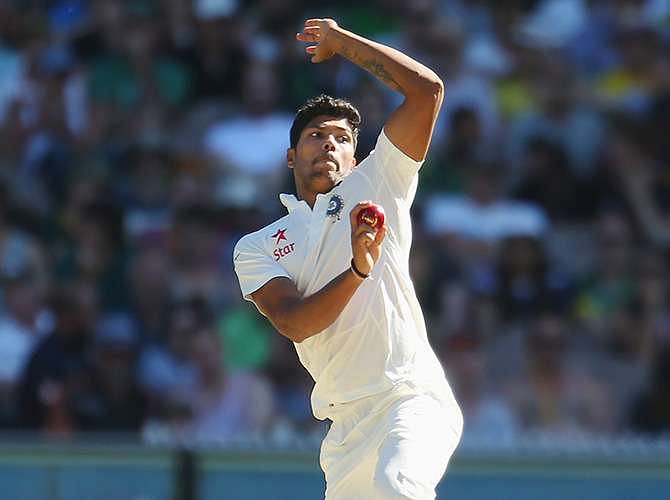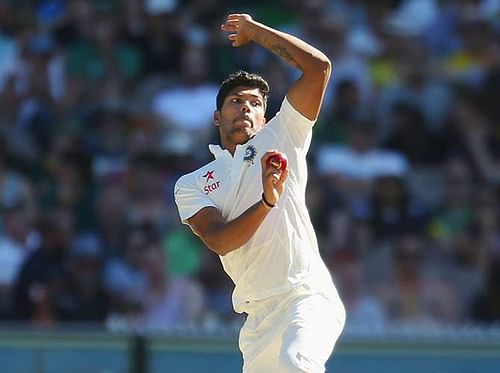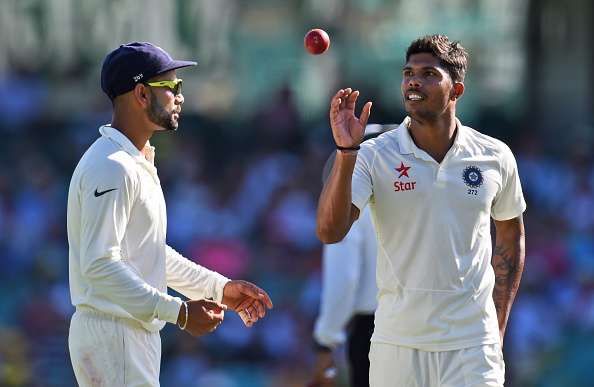
The evolution of Umesh Yadav - From a wannabe policeman to a mean bowling catalyst
There are few sights in world cricket that remain in the memory of a fan for a long time. From yesteryear, it is the Sachin Tendulkar straight drive or the punch off the back foot, that sped away at the rate of knots.
From a bowling perspective, it was Wasim Akram, running in and with that famous whippy action of his, knocking the stumps down with a toe-crusher. From more recent times, it is the sight of Virat Kohli playing a sumptuous cover drive or Mitchell Starc dishing out thunderbolts at searing speeds.
Not often, however, have we heard about an Indian bowler rippling emotions like the one Akram and others did those days. However, it did happen once and what a feeling it was.
The year was 2012. India were playing Australia at the WACA in Perth. It had already become a forgettable tour and was getting worse as the hosts mounted the pressure. But even in such a dire scenario, a young 24-year-old fast bowler provided a moment of magic.
In the 5th ball of the 45th over, Umesh Yadav ran in and delivered an absolutely stunning yorker to peg Ricky Ponting's middle pole back. The delivery had everything that would make a fast bowling legend proud. It was fast, aimed at the foot and eventually, did what it had to.
The impact was not just a stump that lay flat on the ground, but along with it lay broken- the stump mic- and the expectations of the thousands who had come to watch the fading yet still very competent genius of the Tasmanian making a big score.
For an Indian fan, though, the delivery was something to relish. A fast bowler from his heartland, knocking the middle pole back. WOW. Yadav had arrived and how! He then went on to claim his maiden five-wicket haul to bring a smile on the Indian fan's face.
The spell gave a glimpse into the future and it was hoped Yadav would provide more moments of promise in the coming days. But Indian bowlers, in particular the quicker men, have in the last 15 years sailed in a boat, that we need to get to land and squash as quickly as we can.
It is the boat of 'showing promise and then throwing it away'. Munaf Patel is someone who sailed on that. VRV Singh is another. Ishant Sharma, for a long time, looked as he would join the aforementioned names, but seems to have understood the frailties of it and is now slowly swimming his way back.
Yadav found himself moving there and to India's great concern, he was heading there with Zaheer Khan slowly declining, Varun Aaron not becoming what was expected out of him and the rest just not ready yet.
For the next two years of his career, Yadav was erratic and no one knew where he was headed. The pace was there, but the direction wasn't. The talent was there, but the guidance wasn't.
2014- the year the turnaround began
The Indian Premier League is not often said to be a tournament which should be used as a platform to determine whether a cricketer is good or not. The Kolkata Knight Riders were a team that depended on it slow bowlers to win them games, particularly at the Eden Gardens.
Amidst a whole host of spinners, one man stood out- Yadav. He claimed 12 wickets in 11 matches for the Gautam Gambhir-led side and bowled with pace, verve and direction- all aspects that one was so desperately looking out from him.
Gambhir's usage of him was interesting as well. Instead of making him a shadow in front of the spinners, he threw the new ball to him even on slow and low pitches. He used a fast bowler the way that he should be - as a wicket taking option.
The improvement in his game was seen about five months after the conclusion of the IPL. India were playing a hastily-arranged ODI series against Sri Lanka and were 2-0 up, heading into the third game in Hyderabad.
Batting first, the visitors were pegged back early by Yadav and out walked Kumar Sangakkara at three. Usually, Indian bowlers over the years had this habit of bowling a loosener first up, but this was to be different.
Sangakkara stood in the middle, tapping his bat with that low backlift. Eyes wide open. Yadav ran in. The rhythmical action on completion was a delivery that pitched just short of good length, seamed away a touch, hit the left-hander high on the outside half of the bat and carried to R Ashwin at first slip.
It was a superb delivery and like was the case with Ponting in 2012, immediately created an impact. The delivery clocked 140kph on the speed gun and Sangakkara walked back for a golden duck.
“Umesh Yadav's run-up has become a very good one, as compared to the one that he had six months back. A run-up is extremely important and how stable you run up to the wicket is very important and in the last six months, he has improved a lot in that aspect,” former India pacer and Sportskeeda’s expert analyst Chetan Sharma told us in a telephonic chat.
“The other aspect where there has been a change is the wrist position. We have seen in the past, how expensive he was, how wayward he was because on follow through, if you have a wobbly wrist position, then you find it difficult to control the ball.
"Now, the seam position is looking a lot better. He can bowl wherever he wishes to and he has a brilliant control on the ball and you can achieve reverse swing very well only when you have a stable body, a good wrist position and when the ball is travelling over the seam, then the reverse swing will also improve, accordingly," he added.
The signs of a second wind were there, but was there actually one? For the next two months after that dream ball, it didn't seem like. The Nagpur pacer struggled for control, first in the four Test matches against Australia and then in the triangular series that followed and you thought- 'Here we go again'.
Heading into the 50-over World Cup defence, the signs were grim. India looked jaded, the bowling toothless. The fans were worried and it was said a quarterfinal finish would be a serious achievement. Amidst all this talk, the gods were at work to turn the bowlers into mythical creatures overnight, looking for their next prey.
Yadav walked out with the rest of the pack and in the course of the next month-and-a-half, bowled in the manner that would have made the quicks from the yesteryear West Indian squad proud. There was pace, there was discipline and most importantly, it was scary. The lambs had turned lions and MS Dhoni's men were back on track.
India's spectacular journey found a full stop in the semifinals, where the Australians proved to be too good. Incidentally, it was the only game where the bowlers could not take all 10 opposition wickets. Yadav emerged as India's best bowler in the competition with 18 scalps and you hoped this was the catalyst that revitalised his career.
The making of the Test specialist
It’s interesting how one tournament can help you understand more about your craft that ever before.The success in the World Cup had changed Yadav the bowler and all he needed was a leader who backed him.
He found that in the form of Virat Kohli, who, unlike MS Dhoni, liked bowlers with pace. Like Gambhir did at KKR, Kohli used Yadav as a wicket-taking option in Test cricket, a format where he was beginning to take strides, even as he continued to lack the consistency in ODIs.
The critical moment came in the Delhi Test against South Africa. The visitors were 136 for 5 at Tea, looking set to drag the game into the final day. Kohli addressed the team in a huddle just before they walked out for the final session of the day. Yadav got the ball and bowled a spell to remember.
He removed Abbott with a ball so fast, that the stump broke. He then got the outside edge of Dane Piedt's bat which was collected magnificently by Wriddhiman Saha and just like that, the Proteas were reduced to 143 for 9.
It was the kind of hostility that was needed to be seen in Yadav more often and that spell late in the Test really stood out and provided a glimpse into his growth as a cricketer. The following home season has so far proved to be the best one of his career.
Mr. Sharma added that at no cost should Yadav cut down on his pace, adding that the day he reduces his speed, he may not remain the same bowler as he does.
“Absolutely not. He should not listen to anyone. We have lost one very good fast bowler who went by the name of Munaf Patel, who was bowling at 140-145 kph but he heard the advice of a few people and cut his speed down.
The day Umesh cuts his speed down, he will be finished. The improvements that he needed to make in his game, he has made them. All he now needs to do is keep his focus intact and the wickets will follow,” he said.
In the series against England, he might have taken just 8 wickets in 4 matches, but the pace never dropped 140 ever in that series. In the one-off Test against Bangladesh, he gave a bowling masterclass on the third day, a spell that Shakib al Hasan described as the 'best ever he had ever faced in my career'.
In the opening Test at Pune, on a pitch assisting the spinners, he took figures of 6 for 64, in a game that saw both Ashwin and Jadeja take just 12 wickets combined. He was splendid in the win in Bengaluru as well, keeping his end tight even as the spinners were entrusted with the job of winning the game.
Extra Cover: Tracking Umesh Yadav’s evolution into a reliable fast bowler
The usage of the crease is an aspect which every bowler develops over a period of time.
So what has changed in Yadav? For starters, the pace has remained intact. Unlike a lot of bowlers in the past, he has not compromised on that for accuracy. The captain has handled him well. Much credit needs to go to Kohli, for employing him effectively and making him a weapon, even on pitches that had little help for him.
But for me, the biggest change has been the way in which he has made a lot better use of the crease.
Beginning as just someone who bowled from close to the stumps, Yadav now uses the angles of the crease, hence becoming a lot more dangerous against the right-handers in particular. The natural angle tends to take the ball in and if he can learn to take it away from wide off the crease, then he will surely become an even more threatening proposition.
Mr. Sharma added that learning how to use the crease is the most important aspect for a bowler and if he can learn to get the outswinger right from wider of the crease, then there would nothing better than that.
“See, the more you play, the more you will learn. When you learn how to use the crease, then there is nothing bigger than that because the crease is the area of the bowler. If you learn to do that, then the angles will vary and if you can bowl the outswinger from wide of the crease, then there is nothing bigger than that,” he concluded.
I would like to end this piece with an anecdote that Rahul Dravid gave at his Bradman Oration about Yadav:
"We are delighted that Umesh Yadav didn't become a policeman like he was planning and turned to cricket instead. He is the first cricketer from the central Indian first-class team of Vidarbha to play Test cricket"
Thank the heavens for that.

